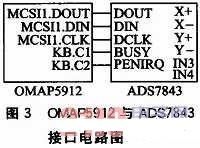A portable wireless communication system is proposed. It uses OMAP5912 as the central processor of the system, uses the Wi-Fi module to build the Ad-Hoe wireless network, uses G729a to encode and decode voice information, and uses the mixing technology to realize the multi-party call function. Tests show that the system does not require a dedicated base station and can realize real-time voice communication anytime, anywhere, suitable for emergency communication and other wireless applications.
introduction
At present, mobile phones have become one of people's daily life due to their convenient and fast calling features. However, it requires base station support. If it is outside the coverage area of ​​the base station, it is difficult for users to communicate. And it is generally only suitable for communication between two users, which is difficult to apply to emergency communications or temporary meetings and other applications. In response to this problem, this paper proposes an embedded system using Wi-Fi (Wireless Fidelity, wireless fidelity) transmission technology. It uses Ad-Hoc for self-organizing networking to achieve the purpose of multiple people talking at the same time. The system does not require a dedicated base station, thereby solving the shortcomings of mobile phones requiring a dedicated network.
1 System design ideas
The wireless multi-party calling system refers to allowing multiple people to have a conversation in the same system at the same time, which is different from the conventional interphone. The two-way radio can only achieve half-duplex communication, that is, the initiator cannot hear other people's voices when speaking. The two parties of the communication are often unable to communicate smoothly because of robbing. If multiple people rob at the same time, the system will not be able to communicate normally.
In order to realize wireless multi-party calling, two key issues need to be solved: the establishment of a wireless local area network and the method of system voice communication. The wireless local area network can use AP-based networking and Ad-Hoc-based networking. The AP-based networking needs to select a central node, which is responsible for forwarding and processing voice information between the following members. However, if the node fails, the entire network will be paralyzed, and the status of each user in the network based on the Ad-Hoc method is equal, and each user can establish a peer-to-peer communication relationship to communicate directly within the coverage of each other. Considering the portability and practicability of the system, the system uses Ad-Hoc based wireless networking.
After establishing a wireless local area network, you can use the RTP protocol to achieve a simple point-to-point voice call. In order to implement a multi-party traffic system, it is also necessary to use multicast. Due to the limited effective bandwidth of the wireless LAN, in order to accommodate more users, it is necessary to adopt a suitable voice encoding and decoding algorithm to reduce the respective bandwidth requirements. Speech coding is generally divided into three types: waveform coding, parameter coding and waveform parameter hybrid coding. Waveform-coded speech has a high degree of naturalness, but the compression efficiency is relatively poor, often above 32 kbps. The characteristic of parameter encoding is that the voice compression efficiency is high, but the naturalness is relatively poor, and it can be encoded at a very low rate. The waveform parameter hybrid coding combines the strengths of the above two, and the representative algorithms are G.723, G.729, etc., which can perform high-quality speech synthesis at a rate of 4 to 16 kbps. Considering the complexity of the algorithm and the demand for voice, the G729a algorithm suitable for embedded applications is selected here. After receiving the voice information of multiple users, the receiver first decodes the corresponding voice, and then adopts the mixing technology to realize real-time answering of multi-person voices.
Considering the portability of the system and the difficulty of system development, Linux2.6 operating system is selected as the software development platform, TI's OMAP5912 is used as the central processor, the wireless network card is used to form the Ad-Hoc network, and Qt technology is used to realize the graphical interface display And system control. Finally complete the function of multi-party traffic communication in the local area network.
2 System hardware design
The system structure is shown in Figure 1. There are N users in the wireless LAN, and the range of N is [2,253]. Each user has the same system architecture, which includes a voice acquisition / playback module, a touch screen, a wireless network card, a central processing unit, and a power module.

2.1 Communication between the central processor and the voice acquisition / playback module
Here select TI's low-power processing chip OMAP5912, which uses the dual-core architecture of ARM9 + DSP55X. The sound card main chip uses TI's AIC23 chip, which is a high-performance stereo voice codec that provides analog-to-digital conversion and digital-to-analog conversion. The data format supports 16/20/24/32 and the sampling frequency supports Adjustable in the range [8 kHz, 96 kHz]. As shown in Fig. 2, the programmable setting of AIC23 is finished through IMAP interface of OMAP5912. The audio data of AIC23 is connected to the MCBSP interface of OMAP5912 to complete the digital audio input / output, while the headset input / output interface of AIC is relatively simple. This circuit can complete its own voice collection and restore the voice information transmitted by other users.

2.2 Communication between the central processor and the touch screen
Considering the intuitiveness of images and the flexibility of manipulation, Samsung ’s LTV350QV_FOE touch screen is selected, which uses 320 & TImes; 240 pixel LCD output. The control of the liquid crystal is completed by the dedicated chip ADS7843. Figure 3 shows the interface circuit diagram of OMAP5912 and ADS7843. OMAP5912 realizes serial input / output of commands and data with ADS7843 through MCSI interface, and multiplexes KB.CX pin into GPIO, and then realizes interrupt trigger of PENIRQ and BUSY signals.

2.3 Communication between wireless communication module and OMAP
The wireless communication module of the system uses an 802.11 wireless network card based on the RT2571 chip. It works in the 2.4 GHz ISM working frequency band and is responsible for the exchange of voice and data information between users. The communication between it and CPU is realized through USB interface.
The whole system is designed with the ultrasonic transmitting and receiving circuit as the core. The system uses the direct digital frequency synthesis chip AD9833 to generate the pulse train. The ultrasonic transducer is driven by the power amplifier circuit. The ultrasonic wave reaches the receiving transducer through the suspension. The digital amplifier AD8307 performs logarithmic amplification on the echo attenuation signal, and finally the microcontroller processes the data to obtain the concentration value. The system is also equipped with keyboard, display, parameter storage, switch output, relay output, current output, UART communication and other functions.
Voltage range of the AC power supply is: 100~240V
The wide range makes the charger compatiable with the voltage standard in all countries. With only 15kgs, it is light weight and easy to carry.
Certificate/Conformity to standards:IEC/IECEX/CE/ROSH/IP68/ISO/EX
The combination of layers and modules is convenient and is unnecessary to use a crane for movement."
User safety, electro Enameled covered with paint and electrical protection according to their performance.
Charging Rack,Usb Charging Rack,Phone Charging Rack,Battery Charging Rack
ZHEJIANG HUACAI OPTIC-TECHNOLOGY CO LTD , https://www.win3safety.com